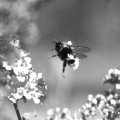A University of Queensland research group is advancing understanding of a gene mutated in the childhood kidney cancer, Wilms' tumour, and in leukemia.
This gene is also critical for normal kidney development.
Group research leader in the University's Centre for Molecular and Cellular Biology Dr Melissa Little leads a team of eight researching the role of the WT1 gene in Wilms' tumour, which affects one person in 10,000.
Dr Little's research group focuses on the delicate balance between cellular proliferation and differentiation which is central to both normal development and cancer.
'During development, there must be strict control over both cellular proliferation and differentiation,' she said.
'Not surprisingly, genes critical for normal development can lead to cancer when mutated. One example of this is the Wilms' tumour gene, WT1.'
WT1 was isolated by a U.S. research team in 1990, and recently interest in the gene has revived with studies on its role in leukemia.
'This gene has been shown by us and others to be mutated in some patients with Wilms' tumour (WT) with the type and timing of the mutation determining whether this occurs alone or together with other anomalies,' Dr Little said.
'WT1 is also known to play a crucial role in urogenital development throughout the vertebrates.'
'This gene has been shown to be mutated in some patients with Wilms' tumour (WT),
Dr Little's group is characterising the normal function of this protein in development and the perturbances required in the same gene to result in abnormalities.
She said Wilms' tumours characteristically appeared, or were detected, in children at about age three. In many cases, they were treatable and in most children, affected only one kidney.
'If there is no family history of the tumours, the affected kidney is removed and chemotherapy used, with an 80 percent success rate,' she said.
'However, if the tumours affect both kidneys or if the tumours have metastasised to the lungs or liver, there is a poor prognosis.'
Dr Little said childhood cancers were interesting genetically.
'If we all live long enough, there is a fair chance of our accumulating enough mutations to get a cancer of some sort,' she said.
'If children with no family history of cancer in the first few years of life develop a tumour, this suggests a simple genetic push. Understanding this process could allow us to find answers to some of the causes of cancer.'
The WT1 gene was one of the earliest genes turned on during kidney development. A small percentage of patients with WT1 mutations developed a condition known as Denys-Drash syndrome.
Denys-Drash results in a predisposition to Wilms' tumour, end-stage kidney failure, and abnormalities in sexual organ development.
In normal development, the WT1 gene has a master role in regulating and turning on other genes involved in kidney development. Such regulation usually occurs by DNA binding.
'We've shown WT1 binds RNA as well as DNA, and we think it plays a role in regulating RNA metabolism. Such findings are turning the field of transcription factors on its head,' she said.
'Many proteins which were thought to act in a very simple way could instead have many levels of action. This finding has implications across the biological sciences.'
(RNA or ribonucleic acid, and DNA, or deoxyriboncleic acid, are the genetic building blocks of life. RNA is the main agent for transferring information from DNA to the protein-synthesizing machinery of cells).
Dr Little said the research group was also investigating other genes involved with Wilms' tumours.
'Although a WT1 mutation will lead to Wilms' tumour, mutations in a number of other genes can produce the same tumour,' she said.
'Wilms' tumours are ?phenocopies' of each other. They look the same, but have different mutations. We know where some of these genes are, but have not identified them. Some are likely to be in the WT1 pathway itself.'
Dr Little has a five-year, $825,000 Sylvia and Charles Viertel senior research fellowship to continue studies characterising the WT1 gene.
For further information, contact Dr Little, telephone 07 3365 4494., email: m.little@cmcb.uq.edu.au, WWW: http://www/iq/edi/ai



